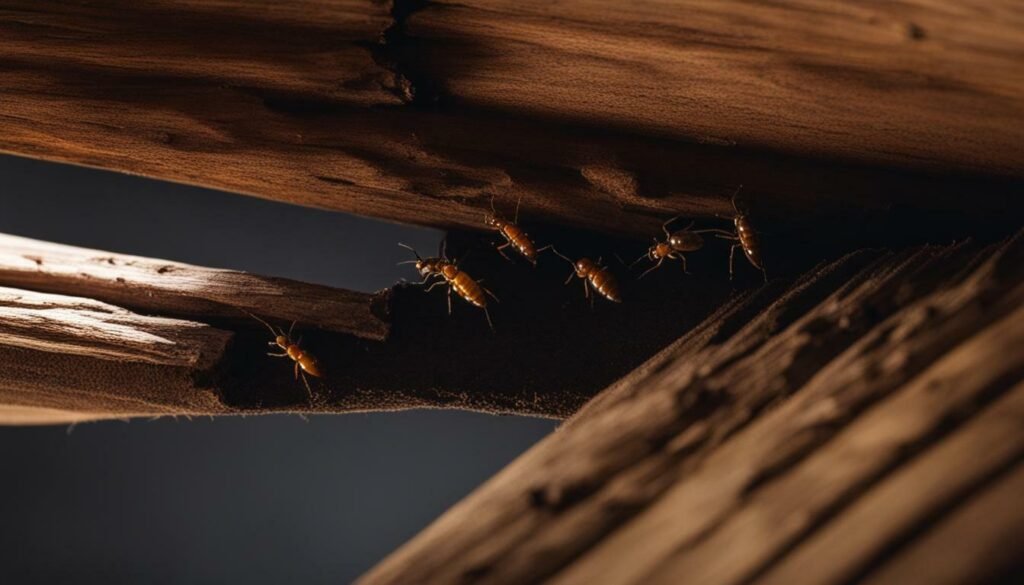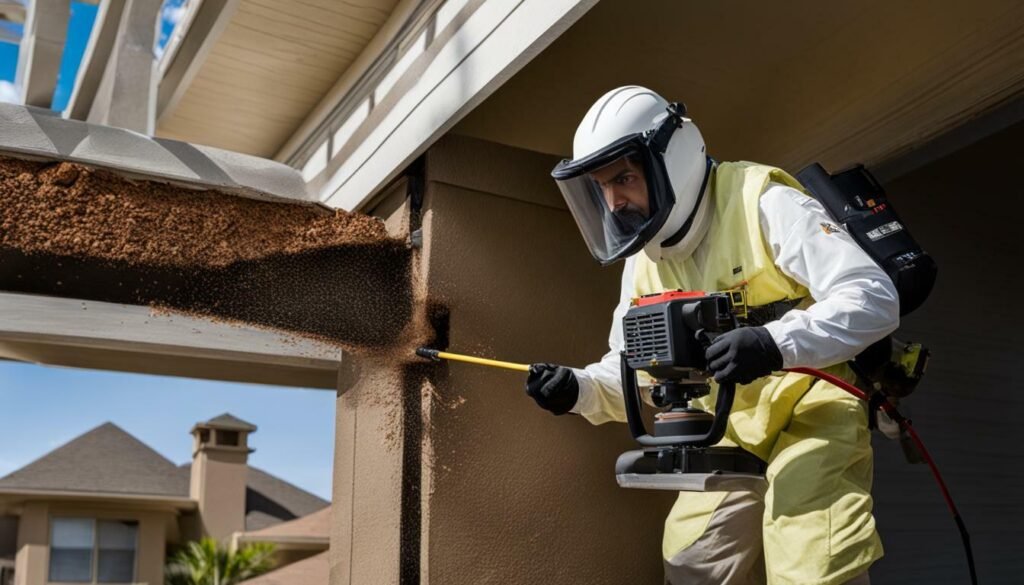The termite treatment building code is a crucial aspect of protecting your home from the damage caused by termite infestations. It outlines the requirements and procedures that need to be followed to prevent and treat termite problems effectively. By understanding this code, you can ensure that your property remains termite-free and structurally sound.
Key Takeaways:
- The termite treatment building code mandates specific forms for new construction, such as the HUD-NPMA-99A and HUD-NPMA-99B forms, which outline the responsibilities of the builder and pest control company.
- Existing properties may require termite inspections and documentation in certain situations, such as when it is customary, mandated by state or local jurisdiction, or evidence of active infestation is found.
- Various termite treatments, including non-chemical methods like physical barriers and biological control agents, as well as chemical treatments like liquid soil-applied termiticides and termite baits, are available to meet the building code requirements.
- Hiring a licensed pest management professional is important to ensure proper application of termite treatments.
- Pesticides used in termite control are regulated by the EPA to ensure safety when used according to label directions.
Mandated Forms for New Construction
The termite treatment building code requires the usage of specific forms, such as HUD-NPMA-99A and HUD-NPMA-99B, for new construction projects. These forms outline the responsibilities of both the builder and the pest control company, ensuring that proper termite treatment measures are implemented.
Builders have crucial responsibilities when it comes to termite treatment. They are required to provide access for pre-construction soil treatments, ensure proper grading and drainage to prevent termite entry, and comply with any soil pretreatment requirements as specified in the building code.
Pest control companies, on the other hand, are responsible for performing pre-construction treatments in accordance with the code. This includes applying an approved termiticide to the soil before the foundation is laid. The pest control company is also required to submit the HUD-NPMA-99A form, which indicates that the treatment has been completed.
Mandated Forms for New Construction:
| Form | Description |
|---|---|
| HUD-NPMA-99A | Documentation of completed pre-construction termite treatment. |
| HUD-NPMA-99B | Builder’s acknowledgement of responsibility for soil pretreatment and prevention measures. |
It is crucial for builders and pest control companies to fully understand their responsibilities outlined in these forms to ensure compliance with the termite treatment building code. By adhering to these requirements, new construction projects can be adequately protected against termite infestations from the start.


Remember, the correct completion and submission of the HUD-NPMA-99A and HUD-NPMA-99B forms play a significant role in meeting the termite treatment building code for new construction projects. By working together, builders and pest control professionals can create structures that are resilient against termite damage.
Termite Inspections and Documentation for Existing Properties
Even existing properties need to adhere to the termite treatment building code, which includes conducting termite inspections and providing relevant documentation when required. These inspections are crucial in identifying and addressing termite infestations to prevent further damage to the structure. Whether it is a customary inspection, a state or local jurisdiction requirement, or the presence of evidence indicating an active infestation, termite inspections play a vital role in safeguarding the property.
During a termite inspection, a licensed pest management professional will thoroughly examine the property, looking for signs of termites or potential vulnerabilities that could lead to an infestation. The inspector will inspect both the interior and exterior of the building, including crawl spaces, basements, attics, and any other areas susceptible to termite activity. If evidence of termite infestation is found, it is crucial to take immediate action to minimize the damage.
The documentation required for termite inspections depends on the specific situation and the applicable building code regulations. However, one commonly used form is the NPMA-33 form, which is used to document termite inspections for existing properties. This form provides a detailed record of the inspection findings, including any evidence of termite activity, the extent of damage, and recommended treatment options.
| Benefits of Termite Inspections and Documentation: |
|---|
| Early detection of termite infestations. |
| Prevention of further damage to the structure. |
| Compliance with building code requirements. |
| Evidence for insurance claims or property transactions. |
By conducting regular termite inspections and maintaining proper documentation, property owners can ensure the structural integrity of their buildings, protect their investments, and mitigate the risk of termite-related issues in the future.


Remember, termite inspections are essential for both new construction and existing properties, as they help identify termite activity and guide the appropriate treatment methods. It is recommended to engage the services of a licensed pest management professional for these inspections, as they have the expertise and knowledge to detect early signs of termite infestations and provide effective treatment solutions.
Available Termite Treatment Options
To comply with the termite treatment building code, homeowners have several treatment options at their disposal, including non-chemical and chemical methods. These options allow for effective management and prevention of termite infestations in structures. Let’s explore the various treatment options available:
1. Non-Chemical Methods:
Non-chemical methods offer environmentally friendly alternatives for termite control. They focus on creating barriers or implementing control measures that do not involve the use of chemical agents. Some common non-chemical methods include:
- Physical Barriers: Installing physical barriers, such as stainless steel mesh or sand barriers, can prevent termites from entering structures.
- Biological Control Agents: Introducing natural predators or parasites to control termite populations. For example, nematodes are microscopic worms that can attack termites.
2. Chemical Treatments:
Chemical treatments are widely used in termite control due to their effectiveness in eradicating termite colonies. The most commonly used chemical treatments include:
- Liquid Soil-Applied Termiticides: These termiticides are applied to the soil around the structure, creating a barrier that termites cannot penetrate. They are effective in preventing termite entry and eliminating existing infestations.
- Termite Baits: Termite baits consist of poisonous substances that are placed strategically in termite activity areas. Termites consume the bait and carry it back to the colony, effectively eliminating the entire population.
It is important to consult with a licensed pest management professional to determine the most suitable treatment option for your specific situation. They have the expertise to assess the extent of the infestation and recommend the most effective treatment method.


Overall, understanding the available termite treatment options is crucial in effectively addressing termite infestations and complying with the termite treatment building code. Whether you choose non-chemical methods like physical barriers and biological control agents, or opt for chemical treatments such as liquid soil-applied termiticides and termite baits, it is essential to prioritize the long-term protection and preservation of your structure.
| Non-Chemical Methods | Chemical Treatments |
|---|---|
| Physical Barriers | Liquid Soil-Applied Termiticides |
| Biological Control Agents | Termite Baits |
Hiring a Licensed Pest Management Professional
When it comes to termite treatment, it is crucial to hire a licensed pest management professional experienced in applying the necessary treatments to meet building code requirements. These professionals have the knowledge, skills, and expertise to assess the extent of a termite infestation and determine the most effective treatment options.
By hiring a licensed professional, you can ensure that the termite treatment application is done correctly and in compliance with the termite treatment building code. These professionals are familiar with the specific forms and documentation required for new construction, such as the HUD-NPMA-99A and HUD-NPMA-99B forms, which outline the responsibilities of the builder and the pest control company. They also understand the importance of termite inspections and proper documentation for existing properties.
When selecting a licensed pest management professional, it is essential to conduct thorough research. Look for reputable companies with a proven track record of successfully treating termite infestations. Reading customer reviews and testimonials can provide valuable insights into their level of service and customer satisfaction.


Remember to ask for proof of licensing and certification from the pest control company you are considering. A licensed professional will have the necessary qualifications and training to handle termite treatments safely and effectively.
Table: Questions to ask when hiring a licensed pest management professional
| Questions | Answers |
|---|---|
| Are you licensed and certified? | [Answer] |
| What is your experience in termite treatment? | [Answer] |
| Do you provide a written treatment plan? | [Answer] |
| Can you provide references? | [Answer] |
| What are your payment terms? | [Answer] |
Hiring a licensed pest management professional gives you peace of mind knowing that your termite infestation will be addressed effectively and in accordance with the building code requirements. Their expertise and knowledge will help protect your structure from further damage and potential costly repairs.
Regulation of Pesticides in Termite Control
The government, through the EPA, plays a significant role in regulating pesticides used in termite control to ensure the safety of both humans and the environment. These regulations aim to protect structures from termite infestations while minimizing the potential risks associated with pesticide use. Understanding the regulations surrounding pesticides is crucial for both pest control professionals and property owners.
When it comes to termite control, the EPA sets strict guidelines on the use of pesticides. These guidelines include requirements for pesticide product labels, which provide essential information on the proper use, dosage, and safety precautions. It is important to read and follow these labels closely to ensure effective and safe termite treatment.
Additionally, the EPA regulates reoccupation timeframes after pesticide application. These timeframes specify how long individuals should wait before entering treated areas to avoid exposure to potentially harmful chemicals. Adhering to these timeframes is vital for protecting both occupants and the environment.


Key Points:
- The government, through the EPA, regulates pesticides used in termite control to ensure safety.
- Pesticide product labels provide important information on proper use and safety precautions.
- Reoccupation timeframes specified by the EPA must be followed to prevent exposure to chemicals.
By adhering to EPA regulations and guidelines, pest control professionals and property owners can effectively and safely address termite infestations. It is essential to stay informed about the latest regulations and practices in termite control to ensure compliance and protect structures from these damaging pests.
Choosing a Reputable Pest Control Company
When faced with a termite infestation, it is crucial to choose a reputable pest control company that follows proper building code guidelines and adheres to safety regulations. Hiring the right professionals can make all the difference in effectively treating and preventing termite damage.
A reputable pest control company will have the necessary licenses and certifications to handle termite treatments. They will employ licensed pest management professionals who are trained in the latest techniques and methods for termite control. These professionals have the expertise to assess the extent of the infestation and determine the most suitable treatment option.
| Key Considerations | Why It’s Important |
|---|---|
| Experience and Expertise | Experienced professionals are equipped to handle various termite infestations and can provide effective solutions tailored to your specific needs. |
| Reputation and Reviews | Reading reviews and seeking recommendations from trusted sources can help you gauge the quality of service a pest control company provides. |
| Licensing and Certification | Ensure the company holds the necessary licenses and certifications required by your state or local jurisdiction to verify their qualifications. |
| Insurance Coverage | Verify that the company carries liability insurance to protect your property in case of any accidental damage that may occur during the treatment process. |
Additionally, it is crucial to thoroughly read and understand the pesticide product label. The label provides important information about the product, including its active ingredients, application guidelines, and safety precautions. Following the label instructions is essential to ensure the safe and effective use of the pesticide.


Choosing the Right Pest Control Company Checklist
- Research and compare different pest control companies in your area.
- Check for licensing and certification.
- Read reviews and seek recommendations from trusted sources.
- Inquire about the company’s experience and expertise in termite control.
- Ensure the company carries liability insurance.
- Ask about the treatment options they offer and their effectiveness.
- Request a detailed written estimate for the treatment plan.
- Ask about any guarantees or warranties offered.
- Verify their knowledge of and compliance with the termite treatment building code.
By choosing a reputable pest control company that prioritizes safety and follows building code guidelines, you can have peace of mind knowing that your termite infestation will be effectively addressed, protecting your property from further damage.
Dealing with Pesticide Misapplication
In case of pesticide misapplication during termite treatment, it is essential to know how to report the incident to the appropriate state pesticide regulatory agency. Misapplication can occur due to negligence, improper handling, or failure to adhere to label directions. If you suspect a pesticide has been misapplied or used inappropriately, it is crucial to take immediate action.
To ensure prompt resolution, follow these steps:
- Gather evidence: Take photographs or videos of any visible signs of misapplication, such as overspray or excessive pesticide residue. Collect samples, if possible, to provide physical evidence of the issue.
- Document details: Write down a detailed account of what happened, including the date, time, and location of the incident, as well as any observations or conversations with the pest control company or applicator.
- Contact the state pesticide regulatory agency: Look up the contact information for your state’s pesticide regulatory agency. They are responsible for overseeing pesticide use and can guide you through the reporting process.
- File a complaint: Reach out to the agency and file a formal complaint, providing all the evidence and documentation you have gathered. Be clear and concise in describing the incident and the impact it has had.
- Cooperate with investigations: If the regulatory agency initiates an investigation, cooperate fully by providing any additional information or evidence they may require. This will help ensure a thorough examination of the incident.
Remember, reporting pesticide misapplication not only protects your interests but also helps prevent similar incidents from occurring in the future. By holding the responsible parties accountable, you contribute to maintaining high standards in termite control and safeguarding the health and safety of both individuals and the environment.
“By reporting pesticide misapplication, you contribute to maintaining high standards in termite control and safeguarding the health and safety of both individuals and the environment.”


| State Pesticide Regulatory Agencies | Contact Information |
|---|---|
| Alabama | Phone: (334) 240-7243 Email: pestreg@agi.alabama.gov |
| Alaska | Phone: (907) 745-7200 Email: pestreg@alaska.gov |
| Arizona | Phone: (602) 255-3664 Email: pestreg@azda.gov |
| Arkansas | Phone: (501) 225-1598 Email: pestreg@state.ar.us |
| California | Phone: (916) 445-2489 Email: pestreg@cdpr.ca.gov |
Government’s Role in Termite Control
The government plays a crucial role in termite control, providing valuable research, information, and regulation to safeguard structures from termite damage. Entities such as the Environmental Protection Agency (EPA), the United States Department of Agriculture (USDA), and state and local agencies are actively involved in ensuring effective termite control measures.
These government bodies conduct extensive research to understand termite behavior, lifecycle, and the most effective methods for prevention and treatment. This research helps in developing innovative approaches and techniques to combat termite infestations. By staying at the forefront of scientific advancements, the government equips pest management professionals with the knowledge required to tackle termite issues.
Moreover, the EPA regulates the use of pesticides in termite control to ensure the safety of both the environment and humans. Pesticides used for termite treatments are subject to stringent regulations, which include labeling requirements, proper application methods, and reoccupation timeframes. The EPA’s oversight ensures that pesticide products used in termite control are effective and used responsibly.
In addition to research and regulation, state and local agencies play a vital role in termite control. These agencies establish guidelines, building codes, and regulations that govern termite treatment practices. They also provide valuable information on termite control measures specific to different regions, taking into account local environmental factors and termite species prevalent in the area.


To further enhance termite control efforts, the USDA collaborates with various stakeholders, including homeowners, pest control professionals, and industry organizations. Their goal is to promote awareness about termite prevention and treatment through educational programs, outreach initiatives, and the dissemination of vital information. By fostering collaboration and knowledge sharing, the government ensures that individuals have access to the latest tools and resources to protect their structures from termite infestations.
Overall, the government’s involvement in termite control is instrumental in safeguarding structures from termite damage. Through research, information dissemination, regulation, and collaborative efforts, they empower individuals and pest management professionals to effectively prevent, detect, and treat termite infestations, ultimately preserving the longevity of our buildings and structures.
Conclusion
Understanding the Termite Treatment Building Code is crucial in preventing and treating termite infestations in structures. Compliance with the code ensures that new constructions use the mandated forms, such as the HUD-NPMA-99A and HUD-NPMA-99B, which outline the responsibilities of builders and pest control companies. For existing properties, termite inspections and documentation are required in specific situations, such as customary practices, state or local jurisdiction mandates, or the presence of active infestation. Using the NPMA-33 form facilitates these inspections.
When it comes to termite treatments, a range of options are available, including non-chemical methods like physical barriers and biological control agents, as well as chemical treatments like liquid soil-applied termiticides and termite baits. To ensure their proper application, it is essential to hire a licensed pest management professional with the necessary expertise and qualifications.
Pesticides used in termite control are regulated by the Environmental Protection Agency (EPA) to ensure safety when used according to the product label directions. It is important to choose a reputable pest control company that adheres to these regulations and also read the pesticide product label. Additionally, being aware of reoccupation timeframes after pesticide application is crucial to maintaining safety.
In the event of pesticide misapplication, it is recommended to file complaints with the state pesticide regulatory agency. They are responsible for handling such issues and ensuring appropriate actions are taken. Furthermore, the government, including the EPA, USDA, and state and local agencies, plays a pivotal role in termite control. They provide research, valuable information, and regulation to protect structures from termite infestations.
FAQ
Q: What is the Termite Treatment Building Code?
A: The Termite Treatment Building Code is a set of regulations that govern the prevention and treatment of termite infestations in structures.
Q: What forms are required for new construction?
A: The HUD-NPMA-99A and HUD-NPMA-99B forms are mandated for new construction. These forms outline the responsibilities of the builder and the pest control company.
Q: When are termite inspections and documentation required for existing properties?
A: Termite inspections and documentation are required in certain situations, such as when it is customary in the area, mandated by state or local jurisdiction, or if evidence of active infestation is found. The NPMA-33 form is used for these inspections.
Q: What termite treatment options are available?
A: Various termite treatments are available, including non-chemical methods like physical barriers and biological control agents, as well as chemical treatments such as liquid soil-applied termiticides and termite baits.
Q: Why is it important to hire a licensed pest management professional?
A: Hiring a licensed pest management professional is crucial to ensure proper application of termite treatments. These professionals have the expertise and qualifications necessary for effective treatment.
Q: How are pesticides used in termite control regulated?
A: Pesticides used in termite control are regulated by the EPA to ensure safety when used according to label directions. It is important to read and follow the pesticide product label.
Q: How should I choose a reputable pest control company?
A: When dealing with a termite infestation, it is recommended to choose a reputable pest control company. Conduct thorough research, read pesticide product labels, and consider recommendations from trusted sources.
Q: What should I do in case of pesticide misapplication?
A: If pesticide misapplication occurs, you can file complaints with the state pesticide regulatory agency. They will investigate the incident and take appropriate action.
Q: What is the government’s role in termite control?
A: The government, including the EPA, USDA, and state and local agencies, plays a significant role in termite control. They provide research, information, and regulation to protect structures from termite infestations.
Source Links
- https://npmapestworld.org/resourcecenter/hud/
- https://www.epa.gov/safepestcontrol/termites-how-identify-and-control-them
- https://www.woodworks.org/wp-content/uploads/wood_solution_paper-Effective-Termite-Protection.pdf
Your Expert in Animal Control and Extermination. Trust our experience for humane, effective pest management, protecting your property and ensuring peace of mind with Michael S.





